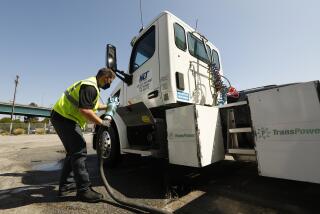Detroit Counting on Cleaner Image for Diesel
- Share via
Despite diesel’s dirty image, Detroit auto makers are continuing to push it as a viable choice for improving fuel economy, particularly for gas-guzzling sport-utility vehicles and pickup trucks.
General Motors Corp., Ford Motor Co. and DaimlerChrysler are all increasing investment in diesel engines even as California and U.S. regulators are raising future diesel emissions standards.
The auto makers are hoping to overcome resistance to a new generation of diesels by using cleaner fuels, refining engine technology further and developing better exhaust after-treatment systems.
One of the more intriguing experiments is underway at DaimlerChrysler, which is testing a clean “designer” diesel fuel developed by Syntroleum Corp., a small petroleum research firm based in Tulsa, Okla.
Syntroleum has developed a gas-to-liquids process for turning natural gas into a diesel fuel that is free of sulfur, aromatics and heavy metals. As a result, it produces fewer smog-causing nitrous oxides, hydrocarbons and particulates (soot-like emissions suspected of causing cancer) than traditional diesel.
Besides the emissions benefits, the synfuel can be used in existing diesel vehicles as well as advanced technology vehicles, including those using fuel cells. The low-sulfur diesel can also make use of the existing distribution infrastructure.
“The use of synthetic fuels is another big step forward,” said Walter Fournier, a DaimlerChrysler product engineer. “We believe they can approach gas in cleanliness.”
Under rules in place in California and under consideration in Washington, diesel vehicles will have to meet the same emission standards as gasoline-powered vehicles beginning as early as 2004. This is a major challenge for auto makers, particularly as more of their sales trend to low-mileage SUVs and pickup trucks.
DaimlerChrysler is demonstrating the new synfuel in its concept Dodge Power Wagon, a brawny, luxury pickup designed after the 1946 workhorse truck of the same name. The Power Wagon is equipped with a huge 7.2-liter, direct-injection turbocharged diesel engine.
The auto maker is showcasing the Power Wagon in several ride-and-drive events this summer, including one at Pebble Beach, Calif., in hopes of displaying the potential of modern diesel engines. The company says diesels using a clean synthetic fuel could provide up to 40% greater fuel economy than gasoline-powered vehicles while reducing greenhouse-gas emissions by half.
The joint venture of DaimlerChrysler and Syntroleum comes as the oil industry is stepping up development of cleaner diesel fuels as well as increasing research into converting natural gas to liquid petroleum.
*
Gas-to-liquids technology could potentially allow the exploitation of trillions of cubic feet of “stranded” natural gas that is too far from markets to be economically extracted or transported. Natural gas, a byproduct of oil production, is now often flared or reinjected into the ground.
Syntroleum builds on the Fischer-Tropsch process developed in 1923 in Germany to turn coal into synthetic gas. The process was uneconomical but was used by Adolf Hitler during World War II and later by South Africa when it faced international economic boycott because of its apartheid policies.
Through various modifications, Syntroleum says, its synthetic fuel can be produced even in small, mobile refineries for as little as $1.50 a gallon, low enough to compete with traditional fuels. The company licenses its technology to six oil refiners, including Atlantic Richfield Co. and Texaco Inc.
Mark Agee, president of Syntroleum, said the technology will allow oil companies to tap inexpensive natural gas that could supply as much as 7% of U.S. daily fuel consumption while providing low-emissions benefits to auto makers.
“The auto and oil industries have a common goal here,” he said.
DaimlerChrysler says the clean diesel could be ready for consumers within five years. It hopes to use it to power advanced diesel engines and eventually in fuel cells to produce hydrogen.
Environmental groups are watching developments closely but remain skeptical. Jason Mark, transportation analyst for the Union of Concerned Scientists in Cambridge, Mass., said the emissions benefits are likely exaggerated since greenhouse gases are created in the synfuels refining process.
“You have to look at it on a wells-to-wheels basis,” he said.
Productivity Gap: Detroit auto makers are making some headway but still trail their Japanese rivals when it comes to running their North American plants efficiently.
The Harbour Report, a closely watched annual measure of manufacturing productivity, found that Nissan, Honda and Toyota take fewer hours on average to produce a car than do Ford, GM and DaimlerChrysler.
The gap was the largest with GM and DaimlerChrysler, each of which spent about 32 hours of labor on each vehicle, compared to Nissan, the efficiency benchmark at about 19 hours.
Toyota replaced Nissan as having the most efficient North American car plant with its Corolla factory in Cambridge, Ontario, Canada; Ford has the most productive truck plant, a Louisville, Ky., factory that builds Explorer sport-utility vehicles.
The most startling statistic from the report: GM could save $4.9 billion a year if it had the same efficiency level as Toyota. It would have to trim 40,041 jobs to do so.
Gen X: More than 40% of new-car buyers 20 to 34, members of the so-called Generation X, lease rather than buy their vehicles, according to a study by J.D. Power & Associates.
The high leasing level is indicative of their interest in driving vehicles priced higher than their income would otherwise allow. The most popular models leased by Gen-Xers are the Ford F-Series pickup and Explorer SUV.
*
Motor City reports news and trends in the industry. Donald W. Nauss, The Times’ Detroit bureau chief, can be reached at don.nauss@latimes.com.






